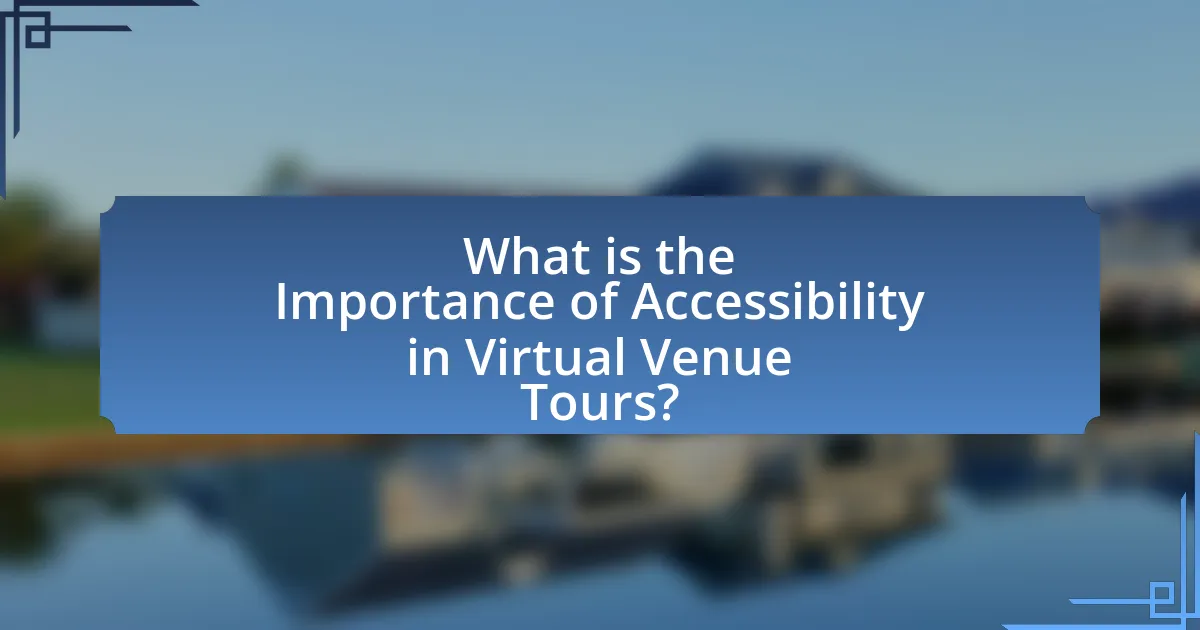Accessibility in virtual venue tours is essential for ensuring that individuals of all abilities can engage with and experience these digital environments. The article outlines the significance of inclusivity, highlighting compliance with legal standards such as the Americans with Disabilities Act and the Web Content Accessibility Guidelines. It discusses the benefits of accessible design, including enhanced user experience and increased audience reach, while also addressing the challenges and barriers faced in implementing these features. Key technologies and best practices for improving accessibility are examined, along with future trends and the role of legislation in shaping accessibility standards.

What is the Importance of Accessibility in Virtual Venue Tours?
Accessibility in virtual venue tours is crucial as it ensures that all individuals, regardless of their physical abilities or disabilities, can experience and engage with the venue. This inclusivity not only broadens the audience reach but also complies with legal standards such as the Americans with Disabilities Act, which mandates equal access to public spaces. Furthermore, studies indicate that accessible design can enhance user experience, leading to increased satisfaction and engagement, ultimately benefiting the venue’s reputation and revenue.
Why is accessibility crucial for virtual venue tours?
Accessibility is crucial for virtual venue tours because it ensures that all individuals, regardless of their physical abilities or disabilities, can participate and engage with the content. By implementing features such as screen readers, captioning, and navigational aids, virtual tours can accommodate diverse user needs, thereby expanding their reach and inclusivity. Research indicates that approximately 15% of the global population experiences some form of disability, highlighting the necessity for accessible design to provide equal opportunities for exploration and enjoyment of virtual spaces.
What are the key accessibility standards relevant to virtual tours?
The key accessibility standards relevant to virtual tours include the Web Content Accessibility Guidelines (WCAG), Section 508 of the Rehabilitation Act, and the Americans with Disabilities Act (ADA). WCAG provides a comprehensive framework for making web content more accessible to individuals with disabilities, emphasizing principles such as perceivability, operability, understandability, and robustness. Section 508 mandates that federal agencies ensure their electronic and information technology is accessible to people with disabilities, which extends to virtual tours. The ADA requires that public accommodations, including virtual experiences, be accessible to individuals with disabilities, ensuring equal access to services and facilities. These standards collectively guide the development of virtual tours to ensure inclusivity and accessibility for all users.
How does accessibility enhance user experience in virtual tours?
Accessibility enhances user experience in virtual tours by ensuring that all users, regardless of their abilities, can fully engage with the content. This inclusivity allows individuals with disabilities to navigate and interact with virtual environments, leading to a more enriching experience. For instance, features such as screen readers, keyboard navigation, and captioning make it possible for users with visual or hearing impairments to access information that would otherwise be unavailable to them. Research indicates that accessible design can increase user satisfaction and retention rates, as evidenced by a study from the World Health Organization, which found that inclusive digital experiences improve overall engagement by up to 30%.
Who benefits from accessible virtual venue tours?
Accessible virtual venue tours benefit individuals with disabilities, event planners, and venue operators. Individuals with disabilities gain the ability to explore venues remotely, ensuring they can participate in events without physical barriers. Event planners benefit by reaching a wider audience, as accessible tours can attract attendees who may otherwise be unable to visit in person. Venue operators also gain from increased bookings and positive reputations, as offering accessible options demonstrates inclusivity and compliance with accessibility standards.
What specific groups are most impacted by accessibility in virtual tours?
Individuals with disabilities, including those with visual impairments, hearing impairments, and mobility challenges, are the specific groups most impacted by accessibility in virtual tours. Research indicates that approximately 15% of the global population experiences some form of disability, which highlights the necessity for inclusive design in virtual environments. For instance, the World Health Organization reports that 2.7 billion people worldwide have a visual impairment, making it crucial for virtual tours to incorporate features like screen readers and audio descriptions to enhance accessibility. Additionally, the National Institute on Deafness and Other Communication Disorders states that about 15% of American adults report some trouble hearing, emphasizing the need for captions and sign language interpretation in virtual experiences. Therefore, addressing these accessibility needs is essential for ensuring equitable access to virtual tours for all individuals.
How do accessible virtual tours promote inclusivity?
Accessible virtual tours promote inclusivity by providing equal access to experiences for individuals with diverse abilities. These tours often incorporate features such as screen reader compatibility, audio descriptions, and sign language interpretation, which ensure that people with visual or hearing impairments can fully engage with the content. Research indicates that approximately 15% of the global population experiences some form of disability, highlighting the necessity for inclusive design in digital environments. By removing barriers and offering tailored experiences, accessible virtual tours foster a sense of belonging and participation among all users, thereby enhancing community engagement and cultural appreciation.
What challenges exist in implementing accessibility in virtual venue tours?
Implementing accessibility in virtual venue tours faces several challenges, including technological limitations, content adaptation, and user experience design. Technological limitations arise from the need for specialized software and hardware that can support various accessibility features, such as screen readers and alternative input methods. Content adaptation is crucial, as existing virtual tours often lack descriptive audio, captions, or sign language interpretation, making it difficult for individuals with disabilities to fully engage with the material. User experience design poses another challenge, as creating an intuitive interface that accommodates diverse needs requires careful consideration and testing. These challenges highlight the necessity for ongoing investment and innovation to ensure that virtual venue tours are inclusive for all users.
What are common barriers to accessibility in virtual tours?
Common barriers to accessibility in virtual tours include inadequate design for users with disabilities, lack of alternative text for images, and insufficient captioning for audio and video content. These barriers hinder individuals with visual, auditory, or cognitive impairments from fully engaging with the tour experience. For instance, a study by the World Health Organization indicates that over 1 billion people globally experience some form of disability, highlighting the necessity for inclusive design in digital environments. Additionally, the absence of keyboard navigation options can further exclude users with mobility impairments, making it essential for virtual tour creators to implement accessible features to ensure equal access for all users.
How can technology address these accessibility challenges?
Technology can address accessibility challenges in virtual venue tours by implementing features such as screen readers, captioning, and virtual reality enhancements. Screen readers convert text to speech, enabling visually impaired users to navigate and understand content effectively. Captioning provides real-time text for audio content, ensuring that individuals with hearing impairments can follow along. Additionally, virtual reality can create immersive experiences that simulate physical environments, allowing users with mobility challenges to explore venues from their homes. These technological solutions enhance inclusivity, as evidenced by studies showing that 71% of users with disabilities report improved experiences when accessibility features are integrated into digital platforms.
How can we improve accessibility in virtual venue tours?
To improve accessibility in virtual venue tours, implement features such as screen reader compatibility, captioning for audio content, and customizable navigation options. These enhancements ensure that individuals with visual or hearing impairments can fully engage with the tour experience. For instance, according to the World Health Organization, over 1 billion people globally experience some form of disability, highlighting the necessity for inclusive design in digital environments. Additionally, incorporating user feedback from individuals with disabilities can guide further improvements, ensuring that the virtual tours meet diverse accessibility needs effectively.
What best practices should be followed for creating accessible virtual tours?
To create accessible virtual tours, implement features such as alternative text for images, captions for videos, and keyboard navigation options. These practices ensure that individuals with visual or hearing impairments can engage with the content effectively. According to the Web Content Accessibility Guidelines (WCAG), providing text alternatives for non-text content is essential for accessibility, as it allows screen readers to convey information to users with disabilities. Additionally, ensuring that all interactive elements are navigable via keyboard enhances usability for those who cannot use a mouse.
How can feedback from users enhance accessibility features?
User feedback can significantly enhance accessibility features by providing direct insights into the specific challenges faced by individuals with disabilities. This feedback allows developers to identify usability issues that may not be apparent during initial design phases. For instance, a study by the World Health Organization indicates that over 1 billion people experience some form of disability, highlighting the necessity for tailored solutions. By incorporating user suggestions, developers can refine features such as screen readers, navigation aids, and alternative text, ensuring they meet the diverse needs of users. This iterative process not only improves user experience but also fosters inclusivity, ultimately leading to more effective and accessible virtual venue tours.
What tools and technologies support accessibility in virtual venue tours?
Tools and technologies that support accessibility in virtual venue tours include screen readers, captioning software, and 3D modeling tools. Screen readers enable visually impaired users to navigate virtual environments by converting text and images into speech. Captioning software provides real-time text for audio content, ensuring that hearing-impaired individuals can access spoken information. Additionally, 3D modeling tools allow for the creation of interactive and customizable virtual spaces that can be designed with accessibility features, such as adjustable navigation options and alternative text for images. These technologies collectively enhance the inclusivity of virtual venue tours, making them accessible to a broader audience.
What software solutions are available for creating accessible virtual tours?
Several software solutions are available for creating accessible virtual tours, including Matterport, Kuula, and Roundme. Matterport offers 3D scanning technology that generates immersive virtual tours with features like 360-degree views and accessibility options for users with disabilities. Kuula provides an easy-to-use platform for creating and sharing 360-degree virtual tours, with accessibility features such as screen reader compatibility. Roundme allows users to create and publish virtual tours with customizable accessibility settings, ensuring a broader audience can engage with the content. These platforms are designed to enhance user experience and ensure inclusivity in virtual environments.
How do assistive technologies integrate with virtual venue tours?
Assistive technologies integrate with virtual venue tours by providing features that enhance accessibility for individuals with disabilities. These technologies include screen readers, audio descriptions, and alternative navigation methods, which allow users to experience the tour fully. For instance, screen readers convert text and visual content into speech, enabling visually impaired users to access information about the venue. Additionally, audio descriptions narrate visual elements, ensuring that users with visual impairments can understand the context of images and videos. Research indicates that incorporating these technologies not only complies with accessibility standards but also improves user engagement and satisfaction, as evidenced by studies showing that accessible design increases participation rates among diverse audiences.
What are the future trends in accessibility for virtual venue tours?
Future trends in accessibility for virtual venue tours include enhanced use of artificial intelligence, improved user interface design, and increased integration of assistive technologies. Artificial intelligence will enable personalized experiences, such as real-time captioning and audio descriptions tailored to individual needs. Improved user interface design will focus on intuitive navigation and customizable settings, making virtual tours more user-friendly for people with disabilities. Additionally, the integration of assistive technologies, such as screen readers and haptic feedback devices, will further enhance accessibility, ensuring that virtual venue tours are inclusive for all users. These trends are supported by the growing emphasis on universal design principles in digital content, which aim to create environments that are accessible to everyone, regardless of ability.
How is the industry evolving to meet accessibility needs?
The industry is evolving to meet accessibility needs by integrating advanced technologies and adhering to established accessibility standards. Companies are increasingly adopting features such as screen readers, audio descriptions, and keyboard navigation to enhance user experience for individuals with disabilities. For instance, the Web Content Accessibility Guidelines (WCAG) serve as a benchmark, prompting organizations to ensure their virtual venue tours are compliant, thereby improving usability for all users. Additionally, the rise of inclusive design practices is fostering collaboration between developers and accessibility experts, leading to more intuitive and accessible platforms. This evolution is evidenced by a growing number of virtual tours that now offer customizable accessibility options, reflecting a commitment to inclusivity in digital experiences.
What role does legislation play in shaping accessibility standards?
Legislation plays a critical role in shaping accessibility standards by establishing legal requirements that organizations must follow to ensure equal access for individuals with disabilities. For instance, the Americans with Disabilities Act (ADA) mandates that public accommodations, including virtual venues, must be accessible to people with disabilities, thereby influencing the design and implementation of accessibility features. This legal framework compels businesses to adopt specific guidelines, such as the Web Content Accessibility Guidelines (WCAG), which provide detailed criteria for making digital content accessible. Compliance with these laws not only helps organizations avoid legal repercussions but also promotes inclusivity and equal opportunity in virtual environments.
What practical tips can enhance accessibility in virtual venue tours?
To enhance accessibility in virtual venue tours, implement features such as screen reader compatibility, captioning for audio content, and keyboard navigation options. Screen reader compatibility ensures that visually impaired users can access information through auditory means, while captioning allows deaf or hard-of-hearing individuals to follow along with spoken content. Additionally, keyboard navigation options facilitate ease of use for individuals who cannot use a mouse, promoting inclusivity. These features align with the Web Content Accessibility Guidelines (WCAG), which recommend such practices to ensure digital content is accessible to all users.


